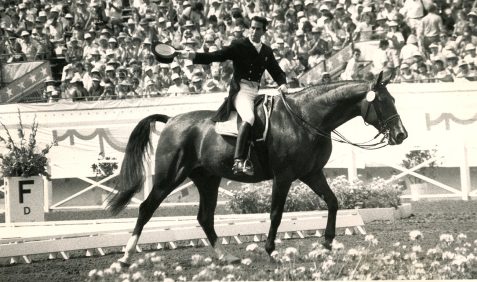Loxahatchee, Fla.—Jan. 17
Have you ever been watching someone’s dressage test and thought, “I wonder what the judge is scoring that movement, and why?”
The Adequan/USDF FEI-Level Trainer’s Conference gave auditors the chance to pull back the curtain and hear directly from some dressage wizards, and to offer up their own opinion as well. Lilo Fore and Hans-Christian Matthiesen spent the second and final day of the conference asking riders to perform mini tests and asking the audience or trainers and judges how they thought it should be scored before explaining how they would score it. The discussion session was then followed up with a brief training exercise to address whatever issues were revealed in the mini test.
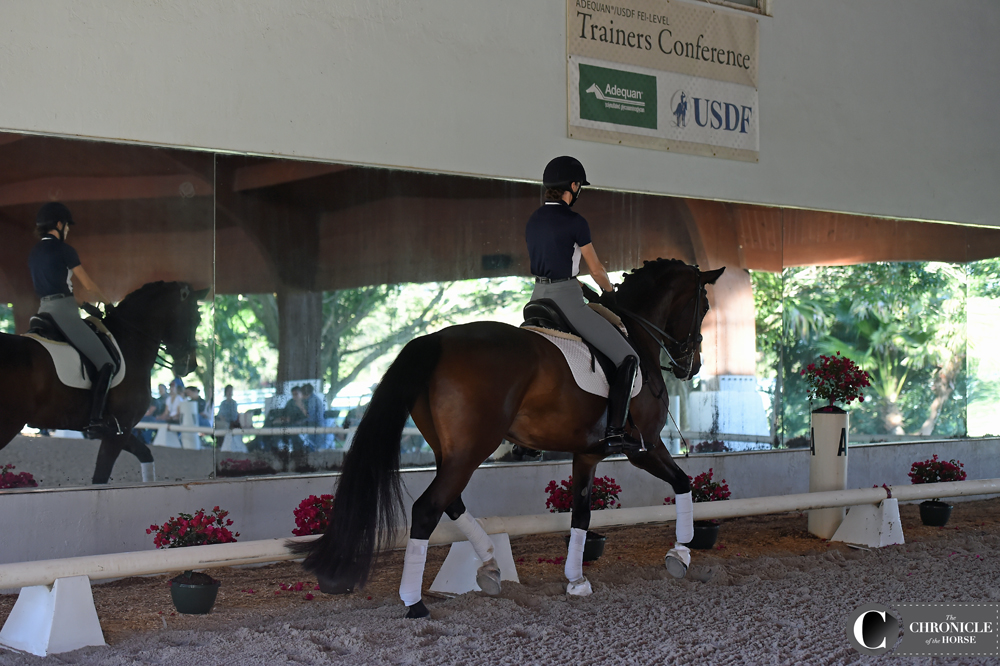
Nora Batchelder and her mare Fifi MLW perform their mini-test for auditing judges and riders. Photo by Ann Glavan.
For example, one of the movements Fore asked for in rider Batchelder’s mini test was a medium trot down the diagonal. After listening to different audience member’s ideas for the horse’s score, Fore explained why she would give it a 7.5, and it had more to do with how Batchelder’s horse, the 7-year-old mare Fifi MLW, got into the medium trot than the movement itself.
“I always teach my rider not to chase the horse out of the corner,” Fore said. “I want my riders to energize their horses on the short side and in the corner, use the short side as your energy ball, get them under their seats, and then they say ‘I’ll allow you forward.’ This horse had a slight change of tempo.”
In the next lesson, rider Elizabeth Caron and her mount Schroeder worked a lot on their collected work and getting a more active canter within the collection. The 12-year-old stallion struggled with his first attempt at the pirouette, and rather than attack the issue head on, Fore had Caron take a step back.
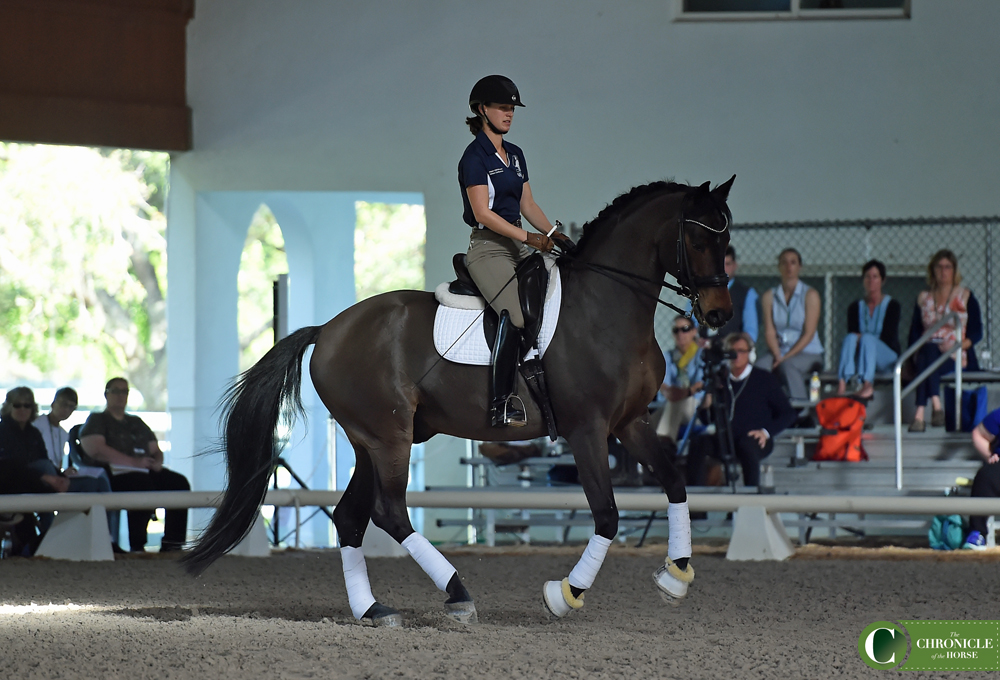
Elizabeth Caron worked on Schroeder’s collection before performing a better pirouette. Photo by Ann Glavan.
Fore had Caron put the stallion in the collected canter on a small circle and asked her to move the haunches in. Once the stallion was moving honestly into the connection in the collected work, Fore stepped out of the circle Caron was riding around her, and asked her to go directly from the exercise into a pirouette, and the resulting movement was much improved—Fore scored the first attempt a 2 because the horse fell off his lead and hopped, and the second attempt pulled a 6.5 in her book.
“I think most people make movements difficult, and they are difficult but we make them more difficult,” Fore said. “Really it should be the horse collects, but collects in a way where he’s still thinking forward. You want to feel the same desire of the horse to canter forward, and then just think shoulders turning around your inner leg. It’s not practicing the pirouette over and over and over, it’s the preparation of the canter, and the control of the shoulder, and then let the horse do its job. That’s it!”
ADVERTISEMENT
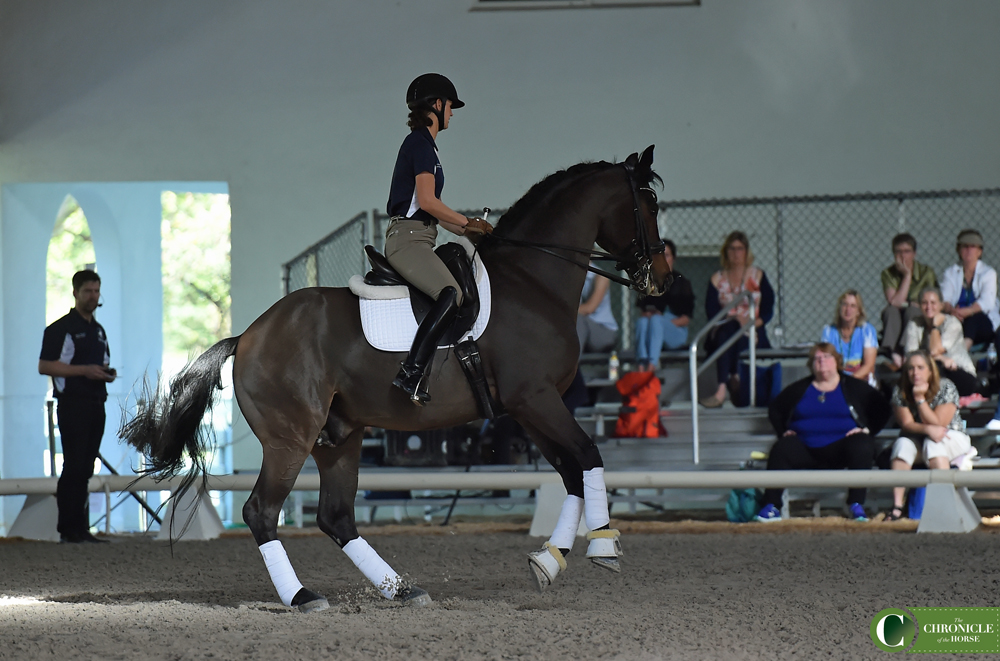
There it is! Elizabeth Caron and Schroeder perform the pirouette. Photo by Ann Glavan.
Fore had another collection exercise in her tool box—a simpler one to help horses and riders build to the more complex movements.
“Sometimes I do a medium canter on the diagonal, and I count how many strides I do, and if I did seven, then the next time I come around and I say ok, can you do one more,” Fore said. “You learn to collect hoof print by hoof print, a little bit at a time.”
And then of course there are the mental strategies riders can use to help them get an idea for how their horse should feel in true collection.
“Always in your mind you have your question, would he do it if I said it, and then you say OK, that’s all I want. That’s what you want in your adjustability,” Fore said. The idea that you could halt the very next step, but don’t.
Though the clinic was billed as a conference for trainers and judges, demonstration rider Karen Pavicic found it to be a very useful learning experience for both her and her horse.
“It’s a fantastic to bring young horses out to get feedback from a top clinician like Lilo and Hans-Christian, they have so many tools in their tool box, and hearing advice from a judge’s point of view and a trainer’s point of view is great,” Pavicic said. “For me one of the reasons I wanted to come to this was to get the horse out in front of a crowd and see how they performed, and I was thrilled with my horse.”
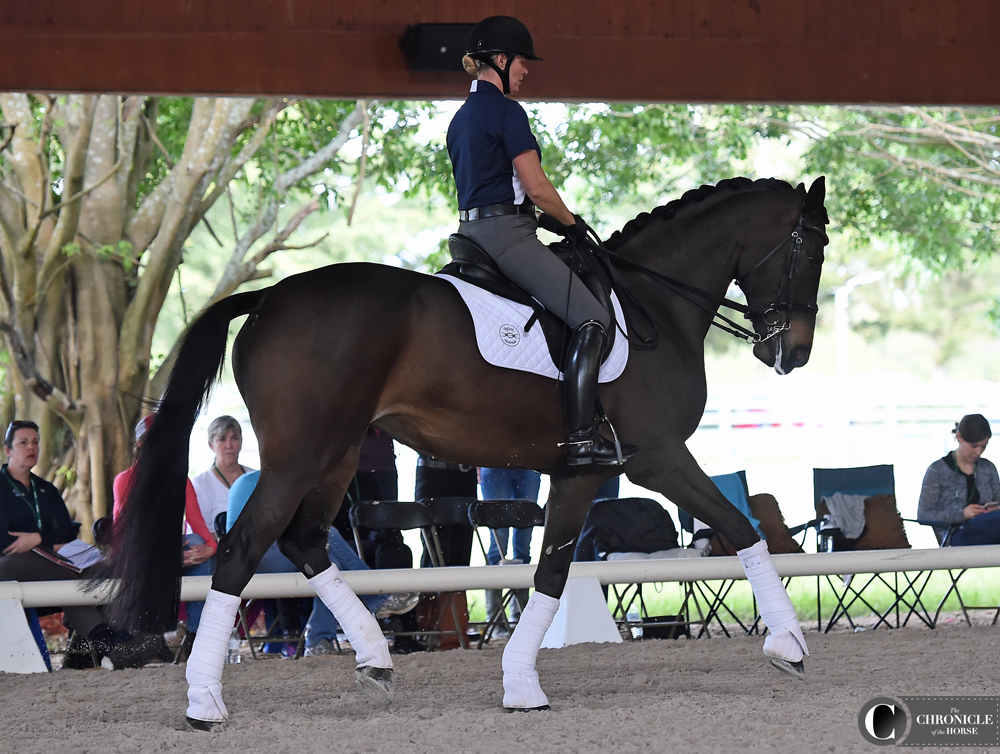
Karen Pavicic puts her 7-year-old mare Beaujolais through her paces. Photo by Ann Glavan.
One of the exercises Pavicic found particularly useful for her 7-year-old mare, Beaujolais, was deceptively simple.
“We were working on canter pirouettes yesterday, and in the 7-year-old test it’s an introduction to the canter pirouette, and Lilo had a great exercise, and she had me ride this five-meter turn from the long side, turning up the first quarter line, so it’s a five meter turn as an introduction to the canter pirouette.”
ADVERTISEMENT
By having Pavicic concentrate on moving her horse’s shoulders to execute the turn correctly and with good energy and contact, first at the walk then at the canter, Fore hoped to give the horse a feel for the connection and shoulder movement it would eventually need in the pirouette.
“It was just very simple, straight forward, low pressure and consistent, it was just a really easy way to introduce it without causing any tension or anything like that,” Pavicic continued. “It’s just really straight forward and simple and horse friendly.”
A lot of time was dedicated to questions, comments and suggested scores from judges, trainers, and auditing riders alike after each rider’s lesson, and Pavicic appreciated the opportunity hear what her fellow equestrians had to say.
“It was helpful for the judges and the trainers to see what the marks were going to be for different movements, and then how you could improve the movements from the trainers’ point of view, I think that’s great,” Pavicic said.
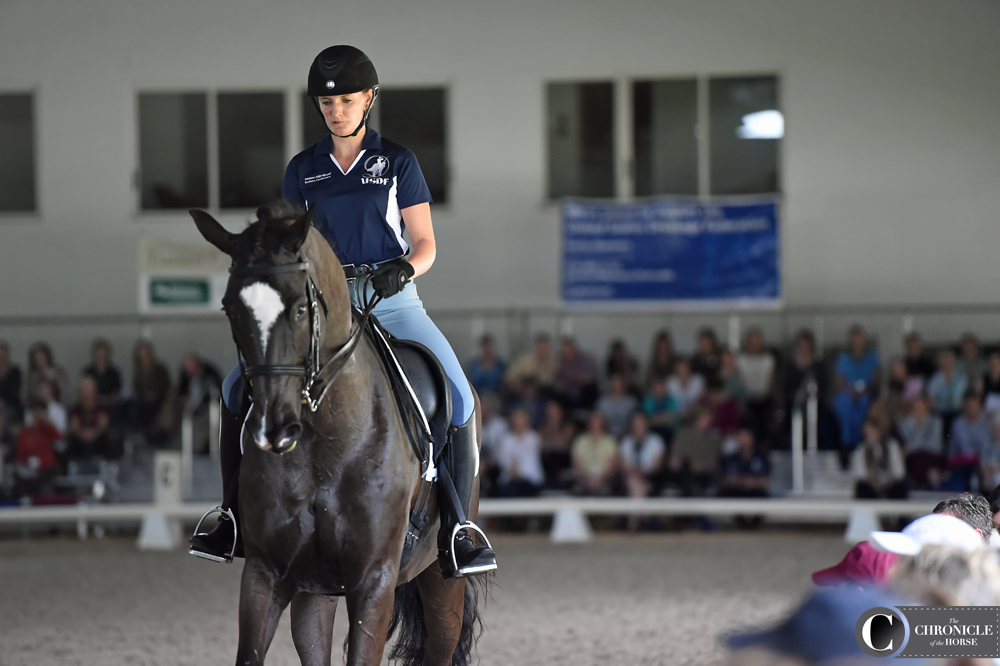
Alexandra du Celliee Muller concentrates as she rides her mini test with Rumba. Photo by Ann Glavan.
“This particular format with the combination of the judges’ input and the trainers’ input, it gives you a completely rounded experience, because as trainers we maybe look at it a little bit differently than what the judges see,” said auditing trainer Carol Conner, who runs Blue Moon Dressage in Bridgeton, N.J.
“What I like about today is it’s giving us as trainers the opportunity to present how we would score it, so you can then kind of test your theoretical knowledge and your eye against these very highly skilled professionals, not just the judges but the clinicians as well,” Conner said. “So it can validate your eye and your philosophy, or it can tell you that you have something to work on!”
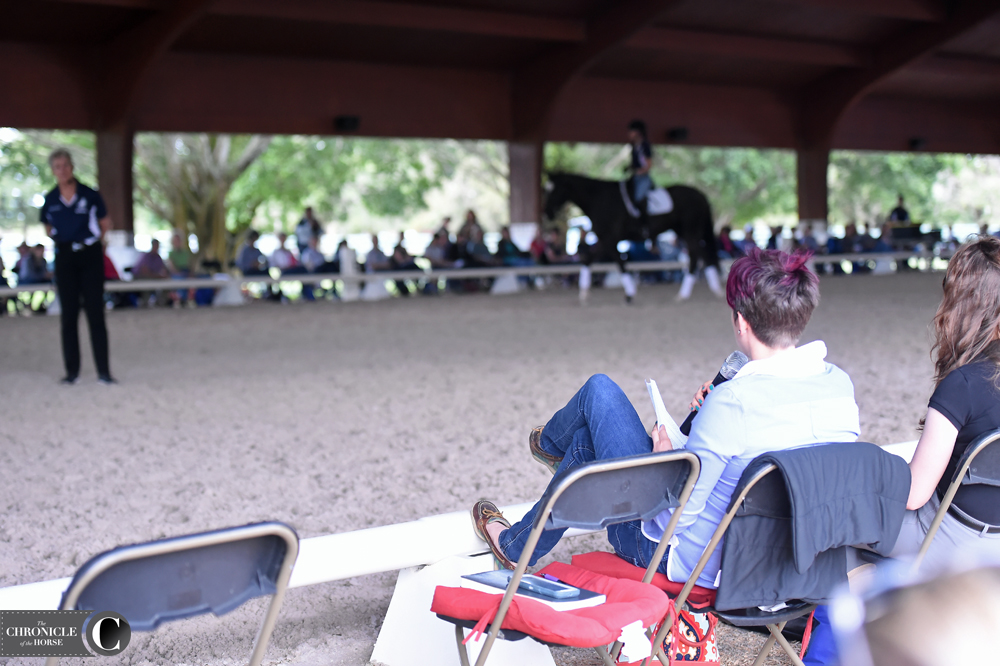
An auditor asks clinician Lilo Fore a question about a rider’s test. Photo by Ann Glavan.
“It’s helpful, this conference, because dressage is changing,” said auditing judge Heinrich Geiemann. “We have more and more better horses with more Thoroughbred, they’re more elegant, but more sensitive. The rider today must be better than the rider of years ago, because they must have more feeling. I know Lilo, she is one of the best judges here in America, and she knows what the trainer needs to do to get the highest points, so this [conference] is a very good idea.”
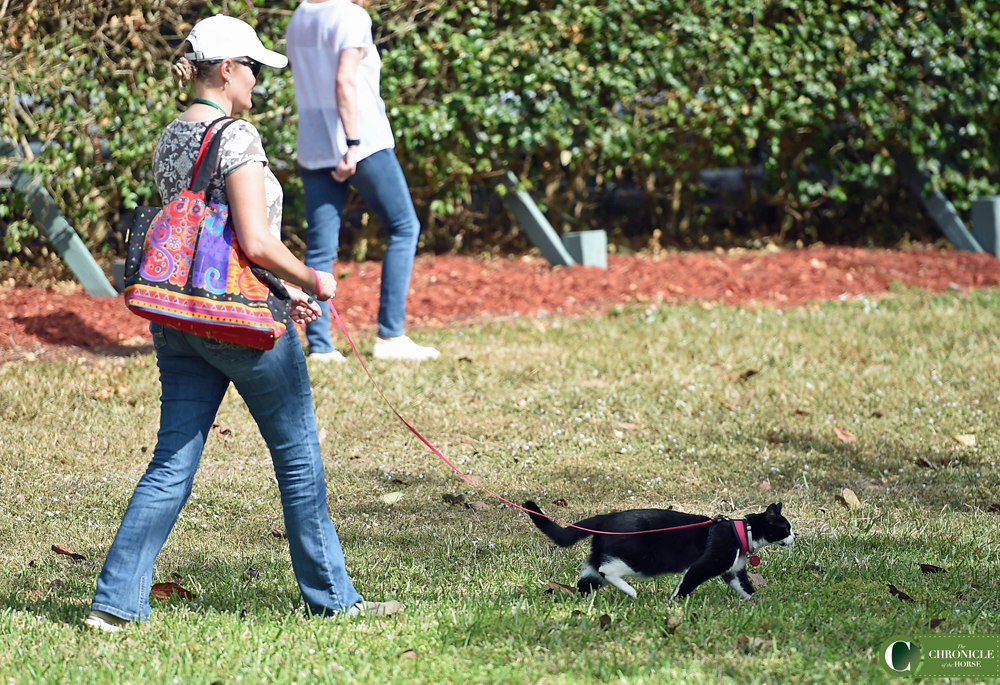
There was a cat on a leash at the conference! Photo by Ann Glavan.






